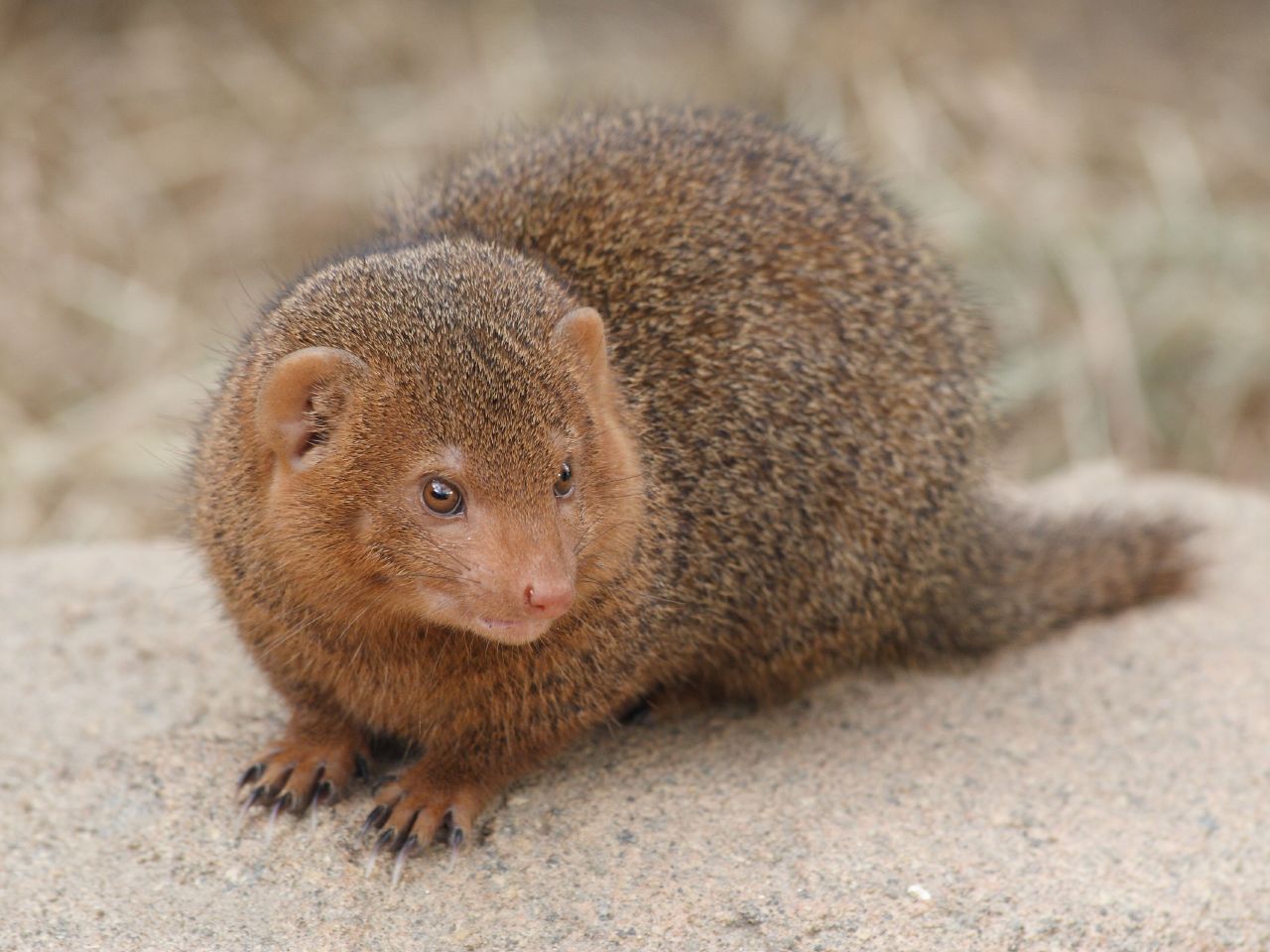
Common dwarf mongoose, or Dwarf mongoose(Helogale parvula)
Phylum —chordata
Class — mammalia
Order — carnivora
Family — herpestidae
Genus – helogale
Appearance
The Common dwarf mongoose is a typical mongoose: it has a large pointed head, small ears, a long tail, short limbs and long claws. The species can be distinguished from other mongooses by its size. It is much smaller than most other species (18 to 28 cm, 210 to 350 grams); in fact, it is Africa's smallest member of the order Carnivora. The soft fur is very variable in color, ranging from yellowish red to very dark brown.
Habitat
Common dwarf mongooses range from East to southern Central Africa, from Ethiopia to the provinces of Limpopo and Mpumalanga in the Republic of South Africa.
Behavior
Common dwarf mongooses are diurnal animals. They are very social and live in extended family groups of 2 to 30 animals. There is a strict hierarchy among same-sexed animals within a group, headed by the dominant pair (normally the oldest group members). All group members cooperate in helping to rear the pups and in guarding the group against predators. Dwarf mongooses are territorial, and each group uses an area of approximately 30-60 hectares. Mongooses mark their territory with anal gland and cheek gland secretions and latrines. Territories often overlap slightly, which can lead to confrontations between different groups, with the larger group tending to win.They sleep at night in disused termite mounds, although they occasionally use piles of stones, hollow trees, etc. Common dwarf mongooses begin and end each day sunbathing and socializing with the members of their groups. The rest of the day these animals spend looking for food among brush and rocks. They communicate with each other with the help of twitters, whistles, trills, and vibrations.
Diet
Common dwarf mongooses are carnivores (insectivores). Their diet consists of beetle larvae, termites, grasshoppers and crickets, spiders, scorpions, small lizards, snakes, small birds, and rodents, and is supplemented very occasionally with berries.
Reproduction
Common dwarf mongooses tend to breed during the wet season, between October and April, raising up to three litters. Usually, only the group's dominant female becomes pregnant, and she is responsible for 80% of the pups reared by the group. If conditions are good, subordinate females may also become pregnant, but their pups rarely survive. After the gestation period of 53 days, 4-6 young are born. They remain below ground within a termite mound for the first 2-3 weeks. Normally one or more members of the group stay behind to babysit while the group goes foraging. Subordinate females often produce milk to feed the dominant female's pups. At 4 weeks of age, the pups begin accompanying the group. All group members help to provide them with prey items until they are around 10 weeks old. Young mongooses attain reproductive maturity by one year of age but delay dispersal, with males usually emigrating (in the company of their brothers) at 2-3 years old. Females normally remain in their home group for life, queuing for the dominant position. They will, however, emigrate to found a new group if they lose their place in the hierarchy to a younger sister.
In captivity
Dwarf mongooses can reach 18 years of age.
A cage for one mongoose must be at least 80×45×60 in size. The animal gets along well with a person, so the cage door can not be closed, thereby giving the mongoose the opportunity to move freely around the apartment. And don't be surprised if he chooses your bed as a place to rest. In captivity, mongooses are neat and clean animals, and it is easy enough to train them to use a toilet.
Mongooses are quite affectionate both within the pack and in relation to humans. The mongoose is a very sociable animal, it constantly chirps something, but not at all loudly, and this chirping is quite pleasant to the ear. This way, they can complain or be happy, encourage you to participate in the game – in general, report what is happening to them. It is even able to respond to a nickname and distinguish its own from others. Also, mongooses perfectly find a common language with other pets.
The menu of mongooses is very diverse. Up to 90% of the diet consists of insects. Reptiles, small rodents, birds and bird eggs, wild fruits, tubers and roots – this fussy animal will eat everything that is suitable for food. Manual mongoose should be fed by combining plant and protein foods. It is not necessary to offer the animal marinated, smoked or fried food.
Of course, keeping a mongoose at home has its pros and cons. This fearless, but accommodating animal will conquer with its affection and curiosity, intelligence and cheerful character, but if there is something to dig up in your house – the mongoose will dig it up. Since the appearance of this animal in the house, you can forget about cockroaches and rodents. If you surround the mongoose with care and attention, it will adore you and everyone it shares a home with.
 Russian
Russian
 English
English
























